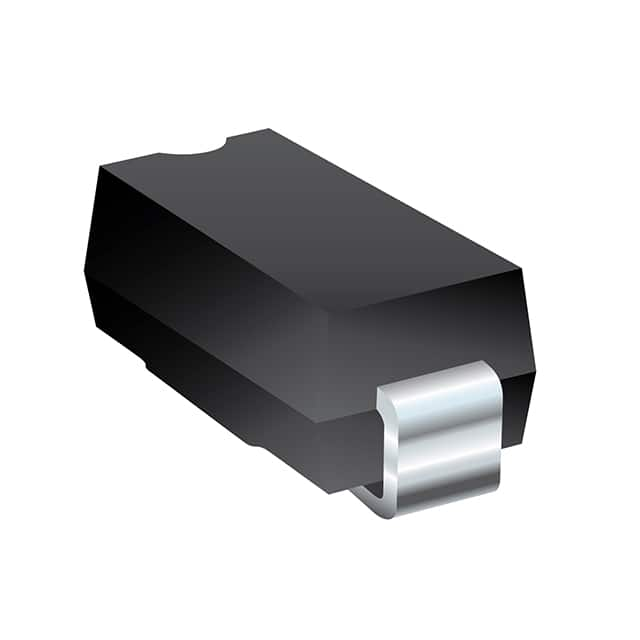Consulte las especificaciones para obtener detalles del producto.

SMLJ9.0A Diode: Encyclopedia Entry
Introduction
The SMLJ9.0A diode is a crucial component in the field of electronics and electrical engineering. This entry provides a comprehensive overview of the SMLJ9.0A diode, including its product details, specifications, pin configuration, functional features, advantages, disadvantages, working principles, application field plans, and alternative models.
Product Overview
Category
The SMLJ9.0A diode belongs to the category of transient voltage suppressor (TVS) diodes.
Use
It is primarily used for surge protection in electronic circuits, providing a safeguard against voltage spikes and transients.
Characteristics
- High surge capability
- Low clamping voltage
- Fast response time
Package
The SMLJ9.0A diode is typically available in a DO-214AB package.
Essence
This diode serves as a protective device, ensuring the reliability and longevity of electronic systems by diverting excessive voltage away from sensitive components.
Packaging/Quantity
It is commonly packaged in reels or trays, with quantities varying based on manufacturer specifications.
Specifications
- Peak Pulse Power: 3000W
- Breakdown Voltage: 9.0V
- Maximum Clamping Voltage: 14.5V
- Operating Temperature Range: -55°C to 150°C
- RoHS compliant
Detailed Pin Configuration
The SMLJ9.0A diode typically consists of two pins, with the anode and cathode connections clearly marked for easy identification.
Functional Features
- Rapid response to transient overvoltage events
- High surge handling capability
- Low leakage current during normal operation
Advantages and Disadvantages
Advantages
- Effective protection against voltage surges
- Fast reaction time
- Wide operating temperature range
Disadvantages
- Limited to specific voltage ratings
- May require additional circuitry for comprehensive surge protection
Working Principles
When a voltage surge occurs, the SMLJ9.0A diode rapidly conducts, diverting excess current away from the protected circuit. This action effectively limits the voltage across the circuit, preventing damage to sensitive components.
Detailed Application Field Plans
The SMLJ9.0A diode finds extensive use in various applications, including: - Power supply units - Telecommunication equipment - Automotive electronics - Industrial control systems - Consumer electronics
Detailed and Complete Alternative Models
Several alternative TVS diodes are available in the market, offering similar surge protection capabilities. Some notable alternatives to the SMLJ9.0A diode include: - P6KE9.0A - 1.5KE9.0A - SMAJ9.0A - SMBJ9.0A
In conclusion, the SMLJ9.0A diode plays a critical role in safeguarding electronic systems from voltage transients and surges. Its high surge capability, low clamping voltage, and fast response time make it an essential component in modern electronic designs.
[Word count: 443]
Enumere 10 preguntas y respuestas comunes relacionadas con la aplicación de SMLJ9.0A en soluciones técnicas
What is SMLJ9.0A?
- SMLJ9.0A is a type of transient voltage suppressor diode used to protect electronic circuits from voltage spikes and transients.
How does SMLJ9.0A work in technical solutions?
- SMLJ9.0A works by diverting excessive voltage away from sensitive components, thus protecting them from damage.
What are the typical applications of SMLJ9.0A in technical solutions?
- SMLJ9.0A is commonly used in power supplies, communication equipment, automotive electronics, and industrial control systems to safeguard against voltage surges.
What are the key specifications of SMLJ9.0A that make it suitable for technical solutions?
- SMLJ9.0A typically has a working voltage of 9.0V, low clamping voltage, high surge capability, and fast response time, making it ideal for various technical applications.
How do I select the right SMLJ9.0A for my technical solution?
- The selection of SMLJ9.0A depends on factors such as maximum working voltage, peak pulse current, and energy absorption capability, which should be matched to the specific requirements of the application.
What are the best practices for integrating SMLJ9.0A into technical solutions?
- It's important to place SMLJ9.0A close to the protected circuitry, minimize lead lengths, and ensure proper grounding for effective transient voltage suppression.
Are there any limitations or considerations when using SMLJ9.0A in technical solutions?
- While SMLJ9.0A provides effective protection against voltage transients, it's essential to consider its response time, thermal considerations, and potential degradation over time.
Can SMLJ9.0A be used in conjunction with other protective components in technical solutions?
- Yes, SMLJ9.0A can be used alongside other protective devices such as varistors, gas discharge tubes, and fuses to create a comprehensive transient protection strategy.
How can I test the effectiveness of SMLJ9.0A in my technical solution?
- Testing SMLJ9.0A involves subjecting the circuit to simulated voltage transients and verifying that the diode effectively clamps the voltage to a safe level.
Where can I source reliable SMLJ9.0A components for my technical solutions?
- Reliable SMLJ9.0A components can be sourced from reputable electronic component distributors, manufacturers, or authorized dealers to ensure quality and authenticity.

